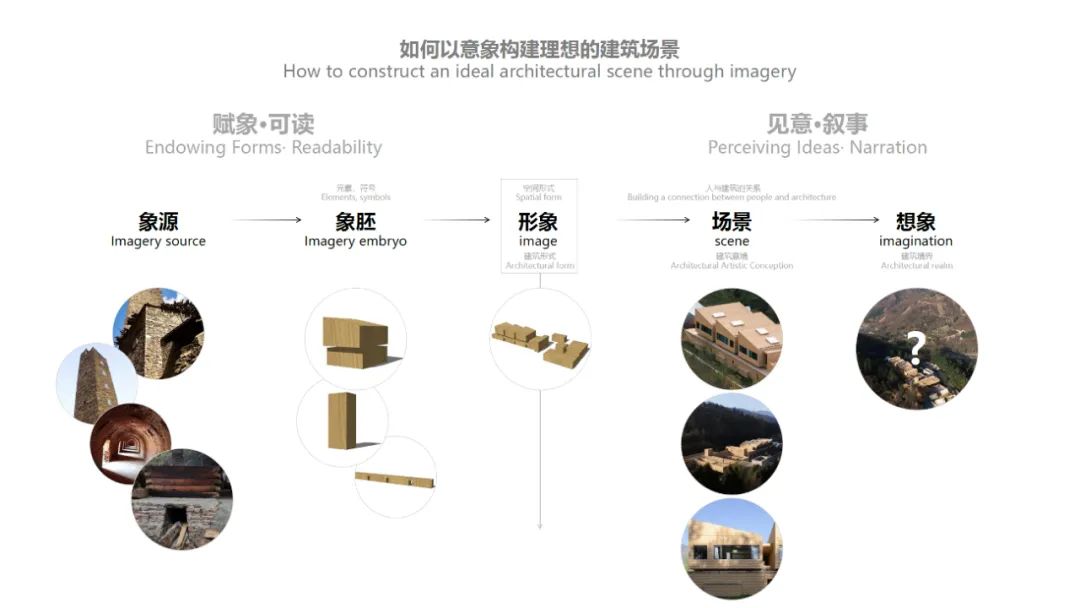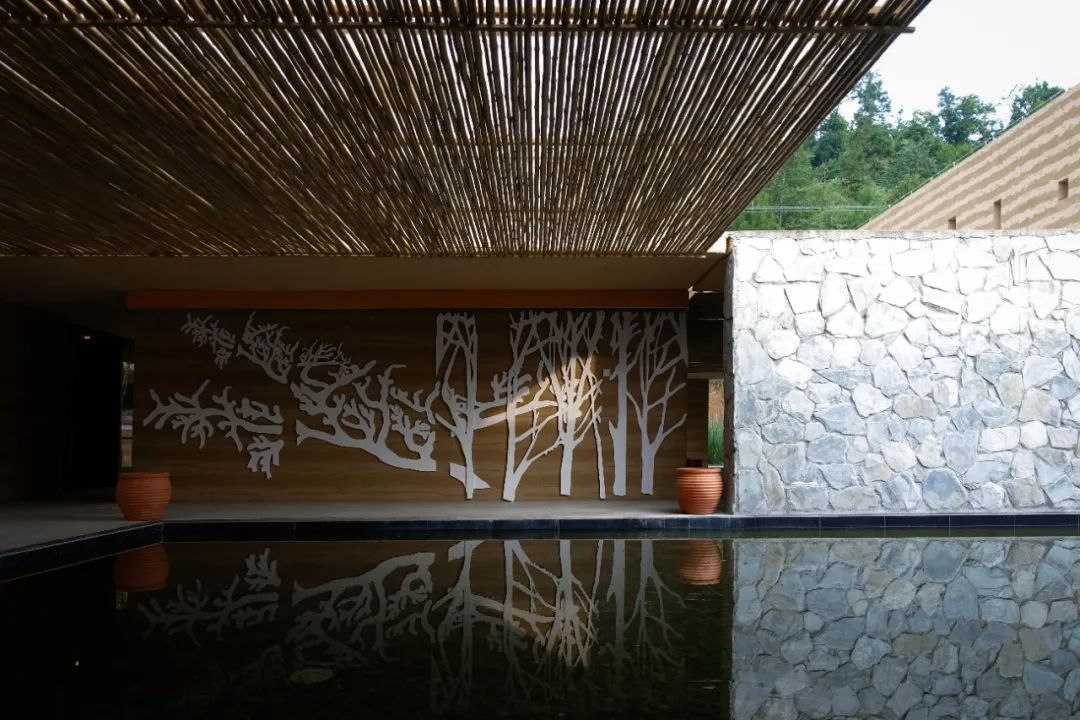
设计单位 小隐建筑事务所
项目地点 四川绵阳
建成时间 2023年3月
建筑面积 1360平方米
撰文 潘友才、葛祥鑫、杨叶
三十辐共一毂,当其无,有车之用。埏埴以为器,当其无,有器之用。凿户牖以为室,当其无,有室之用。故有之以为利,无之以为用。[1]
——《道德经·第十一章》
烘炕、砖窑与羌族民居
项目位于四川平武县平通羌族乡印象梅林景区,距离最近的羌族聚居地“走马羌寨”4公里。青梅是当地最具代表性的产业,“梅宿之言”就坐落在万亩梅林的半坡之上,其原址是一座垮塌荒废的旧砖窑。
The project is located in Impression Meilin Scenic Area, Pingtong Qiang Ethnic Township, Pingwu County, Sichuan Province, China, about 4 kilometers away from the nearest Qiang ethnic settlement called “Zouma Qiang Village”. Green plum is the most representative local industry. Plum Villa is situated in a thousands of acres of plum orchard halfway up the hill, where used to be a dilapidated old brick kiln.

为了长时间存储梅子,当地人都使用一种传统的烘炕将其烘干。烘炕下部为方形的柴火灶,上部为层层叠合的倒梯形木质烘屉,根据梅子由干到湿的程度从下往上依次放置烘屉,倒梯体的形态利于更快地将青梅烘干。这个看似不起眼的烘炕以极其朴素和简洁的方形和梯形两种几何形体构成,凝结了当地人多年的劳动智慧。
To extend the storage time, the local people use a traditional “drying hearth” to dry plums. The lower part of the “drying hearth” is a square-shaped firewood stove, and the upper part consists of layered inverted trapezoidal wooden drying trays. The trays are arranged from bottom to top based on the moisture level of the plums, allowing for faster drying. This unassuming “drying hearth” originate from rectangle and trapezoid, the plain and concise geometric forms, representing the wisdom of local laboring people over the hundreds of years.

当地的羌族民居因其独特的构造和石木土的混合材料应用,具有极强的稳定性。碉楼是其中最具特色的建筑形式,是羌族人用来御敌、储存粮食柴草的建筑。碉楼的高度在10至30米之间,多以石片和黄泥土为建筑材料,建筑墙基很厚,石墙内侧空间是方形,外侧墙体由下而上向内稍倾斜,使其外观呈梯形状。日常居住的碉房呈方形,为石片砌成的平顶房,房顶平台是脱粒、晒粮、做针线活及孩子老人游戏休歇的场地。方形与梯形的结合在当地羌族民居建筑中体现得更加睿智。
The local Qiang ethnic dwellings present strong stability because of their unique construction and the use of mixed materials such as stone, wood, and clay. The watchtower, known as “Diaolou”, is the most distinctive architectural form of Qiang people for defense and storing grain and firewood. The “Diaolou” is usually 10-30 meters high, and is built primarily with stone slabs and yellow clay, it has thick foundations, with square interior spaces and the exterior wall is slightly leaning inwards, giving “Diaolou” a trapezoidal outline. The blockhouse for live named “Diaofang” has a square shape and is a flat-roofed building with stone flakes. The rooftop serves as a space for threshing, drying grains, engaging in needlework, and providing a place for children and the elderly to play and enjoy leisure. The combination of square and trapezoid in traditional buildings reflects the wisdom of local Qiang ethnic groups.

场地上废弃的旧砖窑破败不堪,但内部的拱廊却给人意外的惊喜,光线穿过洞口投射在拱廊内,形成极具仪式感和序列感的空间氛围。
Despite the dilapidated condition of the abandoned old brick kiln on the site, the interior “arched corridor” offers an unexpected delight. Sunlight passing the openings then fall on the walls and ground, creates an atmosphere with a profound sense of ritual and sequence.

青梅烘炕、羌族民居所呈现的共同特征方形与梯形,以及旧砖窑拱廊的光影以一种强烈而“无意识”的印象印刻在我们的脑海中,成为“梅宿之言”最重要的三个“象源”[2],它们都有着极简的几何特征。几何“象源”的获得过程不禁让人想起了阿尔多·罗西的建筑类型学。
The common features of “square” and “trapezoid” in plum drying hearth and Qiang ethnic dwellings, as well as the light and shadow on the corridor in the old brick kiln, all of them leave us a strong and “unconscious” impression, then become the three most significant “imagery source” in our design for the Plum Villa, all of these elements embody highly simplified geometric features. The process of obtaining these geometric “imagery source” is reminiscent of Aldo Rossi's architectural typology.


阿尔多·罗西的建筑类型学
新理性主义的代表阿尔多·罗西创建了建筑类型学理论,在功能与形式之间,罗西更乐于把形式摆在第一位,并认为对现代建筑来说,它们的功能也许在今天有意义,在以后就没有意义了。理论中关于“原型”探寻及提取的理念和方法与我们提出的意象建筑理论的“赋象”、“见意”有着共通之处。
Aldo Rossi, the representative of the New Rationalism, developed the theory of architectural typology. In the balance between function and form, Rossi prioritized the primacy of form. He believed that, for modern architecture, the functions of buildings are meaningful today but may lose their significance in the future. The concept and method of extracting “prototypes” in his theory share common ground with the theory of “Endowing Forms” and “Perceiving Ideas” proposed by Archermit.

类型是自然、社会或艺术大系统中,使形态和结构相同的一组样式聚合为一个有机整体,同时又使形态和结构相异的那些样式分离出去的概念。罗西的原型概念来自于瑞士心理分析家卡尔·荣格的原型理论。荣格所说的原型是指人类心理经验中反复出现的“原始意象”(primordial image),它具有一种不受个人好恶左右的自主性,是一种神秘的、难以言说的形象或者思想力量,这种原始意象也被称为“集体无意识”(collective unconscious)。罗西的类型学的着力点就是这种人类共同经验。
Type is a concept in the large system of nature, society, or art, that a group of styles with similar forms and structures together as an organic whole, at the same time, divide those have different forms and structures. Aldo Rossi, drawing inspiration from Swiss psychoanalyst Carl Jung's theory of archetypes, developed the concept of prototypes in architecture. Jung's concept of archetypes refers to the “primordial images” that repeatedly emerge in human psychological experiences. These images possess a sense of autonomy unaffected by personal preferences and represent a mysterious, ineffable imagery or thoughts. They are also known as the “collective unconscious”. The focus of Rossi's typology lies in these shared human experiences.

罗西在对城市和建筑的原型进行抽取、简化、还原和归类的基础上提出了一整套设计程式:1-引用现存的建筑和片段,2-图像类推,3-换喻,4-产生同源现象。几何形是他用以简化、纯化、点化建筑的手段,他通过各种富有隐喻意义的几何形式间的对比和组合,唤起人们对于几何体之外的某些事物的联想和记忆。罗西的几何学作为一种类型学和原型结构,是想通过对人类远古的建筑意象的发掘,探寻人类共同的美与真;以建筑为媒介,实现一种普遍情感的共振。
Based on the extraction, simplification, restoration, and classification in prototypes of cities and architecture, Rossi proposed comprehensive design approaches: 1) Reference existing buildings and fragments. 2) Analogical inference of images. 3) Metaphor. 4) Generation of phenomena with common origins. Geometry serves as a method of Rossi to simplify, purify, and punctuate architecture. Through the metaphorical contrast and combination with various geometric forms, architecture evokes associations and memories of things beyond geometric shapes. Rossi's geometry, as typology and prototypical structure, aims to explore the shared beauty and truth of ancient human architectural imagery, uses architecture as a medium to achieve a universal emotional resonance.

当我们站在巨人的肩上回看罗西关于建筑类型学的思想,发现它具有一定的局限性,在远古经典建筑意象之外,我们更应该大胆的去探索自然意象,为建筑生成找到更多的原型,赋予建筑更多的可能性。
Reflecting upon Aldo Rossi's architectural typology on the shoulders of giants nowadays, the concepts have its own, it has its limitations. Beyond the ancient classical architectural imagery, we should boldly explore natural imagery and discover more prototypes for architecture, endow architecture with greater possibilities.

器大为屋
“梅宿之言”的设计尝试仅用方形和梯形这两个最简单的几何原型达成,方形和梯形组合成为日常生活中最为常见的几何体“象胚”[3]:长方体和四棱柱,它们不同的尺度对应着生活中各种不同的容器,器皿、家具、建筑亦或是城市。
The design of Plum Villa attempts to use only the two simplest geometric prototypes, square and trapezoid, combined as the most common geometric “imagery embryo” in daily life – cuboids and quadrangular prism. These geometric forms and different scales correspond to various daily objects, such as utensils, furniture, buildings even urban.

在3米的立方体参照系之下,长方体和四棱柱这两个“象胚”以“烘炕”、“羌碉”、“拱廊”的结构逻辑重构,又以羌寨中的院子和巷弄的意象重组,整个空间中有大小串联的院子,有光影丰富的檐廊,最终以极具秩序感的几何形式呈现,构建起了一个小巧的、现代语境下的院落式羌寨。
Within a 3-meter cubic reference system, the two fundamental geometric elements of cuboids and quadrangular prism are restructured with the structural logic on “drying hearth”, “Qiang watchtower”, and “arched corridor”. By combining the imagery of courtyards and alleyways in Qiang settlements, there are connected courtyards with different sizes throughout the building, corridors with beautiful light and shadow, and a strong sense of order and geometric forms in the final presentation of the design. All of these create a small courtyard-style Qiang settlement under a modern context.


建筑材料也是从羌民居常用的石片、黄泥土转化而来,出于严苛的造价控制,石片墙以毛石贴片替代,黄泥土墙则以仿夯土涂料替代。走廊和阳台局部的木架装饰也都取自羌族民居中独特的木头构造。
The building materials come from stone flakes and yellow soil commonly used by local. Due to strict construction cost, the stone flake walls are replaced by rough stone veneer, and the yellow mud walls are replaced by imitation rammed earth paint. Some wooden frame in the corridors and balconies are also inspired by the unique wooden structures in local buildings.


川西的风景有大山大水的壮丽,有天高云淡的辽阔,有风土人情的原生。设计为了将美景引入室内,将传统羌族民居的小窗户替换为全落地玻璃门窗。
The landscape of western Sichuan is known for its magnificent mountains and rivers, vast sky local culture and customs. To bring more scenery into the building, the traditional small windows on Qiang residences are replaced with floor-to-ceiling glass doors and Windows, we expect to give more space back to nature rather than artificial decoration.



我们将更多的空间交给了自然,用不同主题形式的院子和连廊将各个功能区域连接。公区的接待、餐厅、茶室、酒吧通过水院和光院串联起来,两个院子强化了空间层次,同时也营造了更多趣味和闲散的氛围。
Various functional areas are connected by courtyards and corridors in different thematic forms. Reception areas, dining spaces, tea rooms, and bars are interconnected through water courtyards and light-filled courtyards, creating a dynamic spatial hierarchy and an atmosphere for fun and leisure.




“烘炕”类型的模块单元客房被三组半户外的楼梯分隔,再通过拱廊串联起来,设计在强化几何秩序感的同时,使得楼梯和拱廊亦成为独特的观景通廊。
The guest rooms, organized in “drying hearth” modular units, are separated by sets of semi-outdoor stairs and connected through “arched corridors”. These reinforce the sense of geometric order also provide unique corridor views.




平屋顶延续了羌族人在房顶游戏休歇的传统习惯,成为公共的观景休憩平台。群山环绕的壮美之间,一盏茶、一杯咖啡或是一壶浊酒伴着鸟语清风,还有漫天的星河,十分惬意。
The flat roof extends the traditional Qiang habitude of using rooftops for leisure, offering a public platform for surrounded magnificent scenery. With a cup of tea or coffee, or have a drink with friends accompanied by birdsong, gentle breezes, and a starry sky, what a truly delightful experience.


“梅宿之言”取自羌族民居方形和梯形两个最简单的几何原型,搭配羌族民居惯用的石、土、木三种建筑材料,重新塑造了一个融于自然、又具有当代性的新式羌族民居聚落,设计将古老的羌族民居的意象以更加简练的几何语言表现出来。
The Plum Villa takes the two simplest geometric prototypes, square and trapezoid, from traditional Qiang dwellings, along with the three commonly used building materials of stone, clay, and wood, reshapes and redefines a building origins from Qiang ethnic dwelling under contemporary context that harmonizes with nature. Through a concise geometric language, it expresses the imagery of ancient Qiang dwellings.


器小为用
长方体和四棱柱构建的建筑空间激发了我们另外一个有趣的想法,我们将组成建筑的几何体在0.3米的立方体参照系之下进行了再设计,以另外一个尺度赋予这些“象胚”更多“见意”的可能性,这些几何体以1:10的“建筑模型”的形式,转换为各种各样的家具、器皿、装饰摆件。在这个小的尺度之下,这些几何体散发出另一种迷人的魅力,遗憾的是这些器物最后没有能够成为现实。
The architectural space constructed with cuboids and quadrangular prism has sparked another intriguing idea. We have undertaken a redesign of the geometric forms which applied in the design of the building, using a 0.3-meter cubic reference system, to explore new possibilities and imbue these “imagery embryos” with more “perceiving ideas” under a different scale. These geometric forms, transformed into various furniture, utensils, and decorative objects, take the form of 1:10 “architectural models”. With this smaller scale, these geometric forms create another captivating charm. Unfortunately, these objects were not realized in the end.



设计图纸 ▽





注释
[1] 译:三十根辐条汇集到一根毂中的孔洞当中,有了车毂中空的地方,才有车的作用。揉和陶土做成器物,有了器具中空的地方,才有器皿的作用。开凿门窗建造房屋,有了门窗四壁内的空虚部分,才有房屋的作用。所以,“有”为实体,创造出“无”,“无”亦有它的作用。
[2] 象源:设计灵感的来源,分为源于自然的自然物(如:日月星辰、江河湖海、花草树木、飞禽走兽、气候季象……)和人为创造的人造物(如:建筑、服饰、饮食、文学、艺术、历史、语言、交通……)。
[3] 象胚:即建筑原型,通常所说的设计元素、象征性的符号等等。根据设计目标所需,通过大量的分析研究,从海量杂糅的信息中将最契合设计目标的事物抓取,通过简化、纯化、抽象等处理后,转化为象胚。
完整项目信息
主创团队:小隐建筑事务所
主持建筑师:潘友才
设计总监:杨喆(合伙人)
技术总监:陈仁振(合伙人)
结构工程师:杜旭
设计团队:赵亚线、杨锐、冯煜桃、苟源君、胡沁梅、刘子轩、宋智颖、何仪
施工图团队:福州盈创筑业工程设计有限公司
业主单位:平武县光大国有投资(集团)有限公司
施工单位:四川宏瑞鑫建设工程有限公司
摄影:存在建筑、小隐建筑
撰文:潘友才、葛祥鑫、杨叶
项目地址:四川省绵阳市平武县印象梅林景区
建筑面积:1360平方米
建筑材料:仿夯土涂料、毛石贴片、原木、聚碳酸酯板、竹竿
建成时间:2023年3月
版权声明:本文由小隐建筑事务所授权发布。欢迎转发,禁止以有方编辑版本转载。
投稿邮箱:media@archiposition.com
上一篇:俞挺Wutopia Lab新作:铜堡,全金属外壳
下一篇:玻璃城堡:越南CoCo Cha台湾茶与咖啡馆 / PT Arch studio